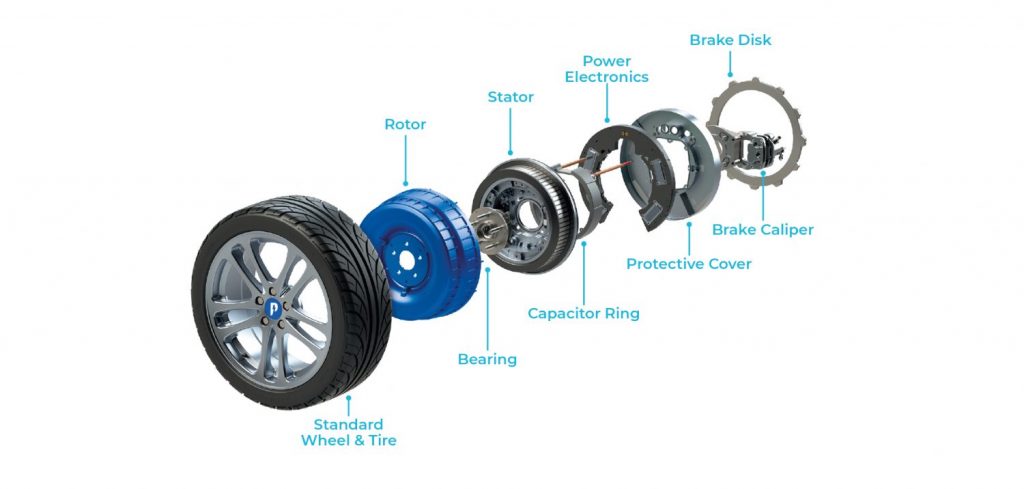Founded in 2008, automotive technology company Protean Electric specializes in in-wheel motor technology. Having developed in-wheel, electric-drive systems for hybrids, plug-in hybrids and battery electric vehicles, the company says more than a million miles have been driven in vehicles powered by its motors.
The result is a permanent magnet e-machine that has power electronics and controls packaged within a wheel, capable of producing high torque and power density figures. The in-wheel equipment has been produced in low volume by Protean and has since been licensed to Tier 1 automotive and global automotive supply companies. Automotive Testing Technology International spoke to Chris Hilton, CTO at the company, to find out more about both its technology and development processes.
Can you explain the basis of Protean Electric’s in-wheel motor technology?
The ProteanDrive IWM (in-wheel motor) design is a fully integrated package that includes all the core technology of an electric powertrain within a single unit. It incorporates a permanent-magnet synchronous motor, with electronics tightly integrated, all within the wheel rim. A friction brake system has been designed with a third-party specialist to fit in the wheel with the motor, complementing the regenerative braking capability of the motor.
The rotor of the electric motor connects directly to the hub, directly delivering torque from the motor to the wheel, so removing losses in power transfer. This direct drive configuration is reflected in the high-torque, low-speed design of ProteanDrive.
To date, our motors have completed over 2,000,000km of testing and have a 300,000km design life.
How much virtual testing did you do and what aspects of the systems are you able to simulate well?
Modeling and simulation at the sub-system and full-system level is a fundamental part of our design and verification methodology. Without it, arriving at a product that meets all requirements and is competitive would be an impossible task.
Finite element analysis (FEA) is the most commonly used simulation method and can provide accurate insight into the electromagnetic performance of the motor, thermal behaviour and the mechanical integrity of the structure. Additionally, computational flow dynamics (CFD) allows us to study coolant flow through the motor, ensuring it can do its job effectively without the pitfalls of excessive flow speed, back pressure or cavitation. Electronics behavior is simulated with Spice simulations.
These simulation methods in themselves can be very accurate, but there are always uncertainties in the descriptions of the behaviors of certain materials and the interfaces between them. For this reason, it is critical to correlate simulations with laboratory measurements. Having been round this loop several times in our history we now achieve very good fidelity in our simulations, meaning that we expect our systems to behave in physical testing in a way that is very similar to the predictions from simulation.
 Do you work with full vehicle models as well?
Do you work with full vehicle models as well?
Most of our simulations relate to the motor system itself, but there are occasions when modeling of the vehicle is required. As an example, in-wheel motors offer great opportunities to improve a vehicle’s dynamic behavior by using the ability to demand torque independently at the driven wheels. We use vehicle dynamics modeling to simulate the impact of this and to establish the best algorithms for improving handling.
What about lab testing?
Lab testing is an important part of the work we do to prove that the function, performance and durability of our product is suitable for use in the real world. We test at material, component and sub-assembly levels initially to verify the building blocks used in our design, before progressing to full assembly verification.
Our product is a novel application of an electric drivetrain, which means that our lab testing often involves developing our own innovative test equipment and procedures to verify aspects that would not need to be considered with a more conventional centralized system. Even with more common aspects such as vibration or ingress protection we usually test to much stricter levels than would be used for a central drivetrain to account for the harsh environment we know our product will need to survive. Our test lab is located in our headquarters in Farnham, UK, and has a wide range of equipment that enables us to test most aspects of our product in-house.
Are you working with any other partners to test/integrate the technology in production applications?
We have worked with tens of customers who have integrated our motors into their vehicles and tested them in various ways. The vehicles include passenger cars, SUVs and light commercial vehicles, and the testing that our motors have undergone with customers ranges from dynamometer evaluation through to full lifetime durability on vehicles, both on- and off-road. Having been through that we have high confidence in the ability of our motors to survive whatever life on a vehicle may throw at them.
We are continually working to improve durability of the product, and as of now we are in a position where our motors have passed full lifetime durability testing with customers without failures.
The approach to ensuring durability starts with establishing the requirements and designing the validation testing that will prove that the requirements have been met. We have worked with OEMs to understand their expectations for components at the wheel-end related to the environment. This covers shock and vibration, plus water, dust and other substances to which the in-wheel motors will be subjected.
We adopt the most stringent requirements that we find so that we can be confident that our motors will meet the durability requirements of our customers. Having designed to the requirements and proven in simulation that the design is good, we then turn to durability testing which is carried out at the sub-component level initially, and then in the fully assembled product, and finally, on vehicles.
We have not found applications with environments so harsh that we believe in-wheel motors can’t achieve durability. In fact, we’ve passed off-road durability validation with a customer with the same product that we supply for on-road use. This is because the motor is not in direct contact with the wheel rim except at the bearing interface. We design in a gap which ensures that even rather major damage to the wheel rim does not result in damage to the motor. We also ensure that a curb strike severe enough to damage the suspension will not damage the motor. We recognize that it is an expensive component that a vehicle owner will not want to replace as a result of a minor accident.


